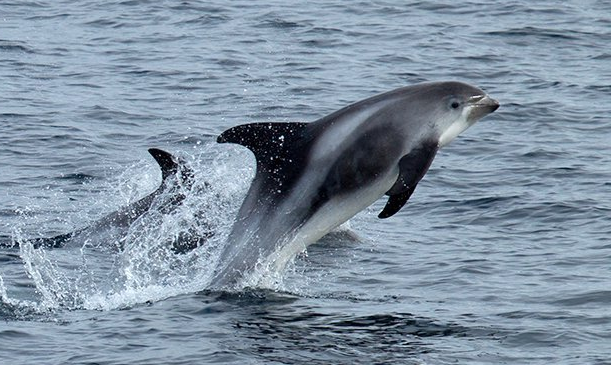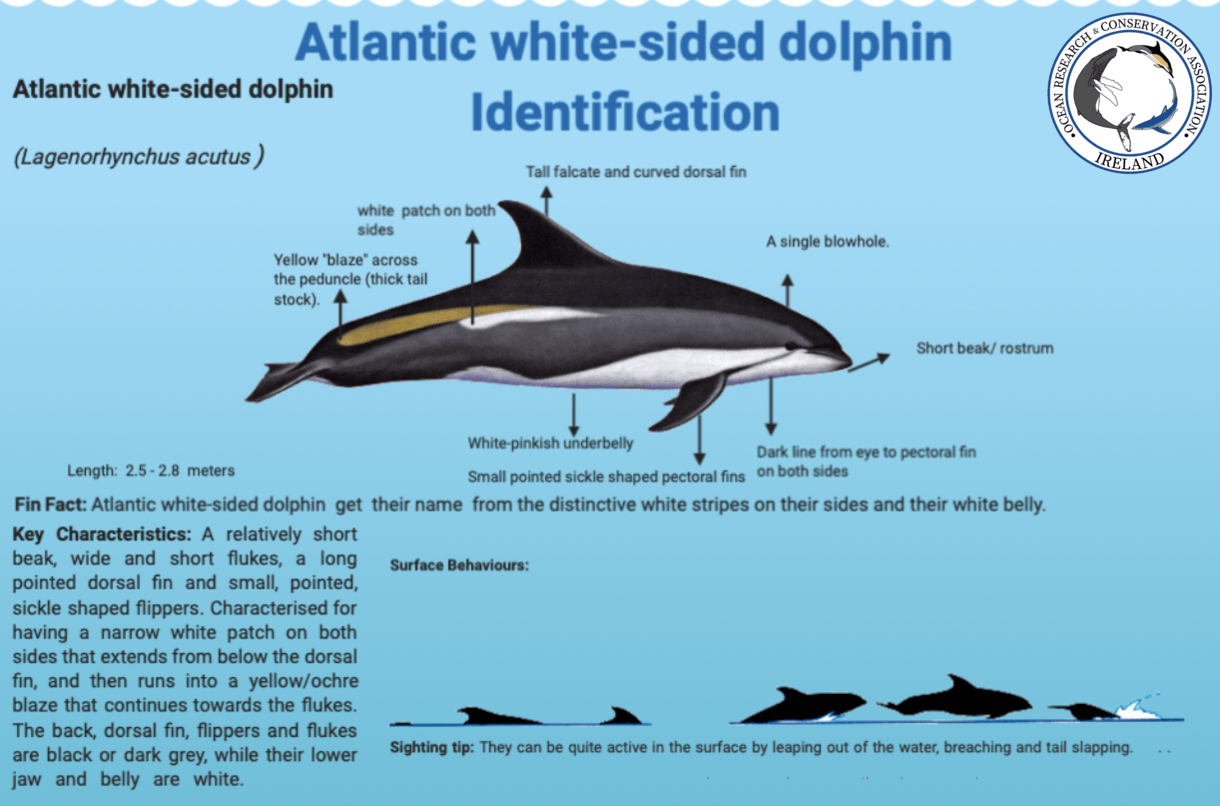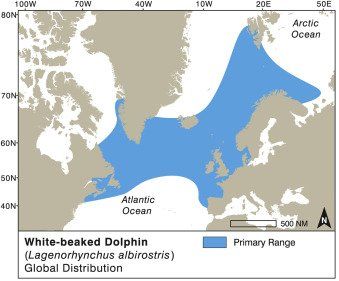Classification:
Kingdom: Animalia
Phylum: Chordata
Class: Mammalia
Order: Artiodactyla
Infraorder: Cetacea
Family: Delphinidae
Genus: Lagenorhynchus
Species: L. albirostris
Get the facts:
The white-beaked dolphin is a large and robust dolphin species which is usually found in the cold waters of the North Atlantic Ocean. Sometimes they can be misidentified with the Atlantic white-sided dolphin. Their name albirostris means “white beak”, the most well-known feature of this species. However, some individuals lack this characteristic and their beak coloration can vary.
Species identification:
The white-beaked dolphin is a robust and large dolphin. An adult has an average size that varies between 240 to 280 cm and they can weigh between 200 to 300 kg. Males are generally larger and heavier than females. They have 22 to 28 conical teeth in both their upper and lower jaw. They are characterised for having a short and thick beak about 5 cm to 8 cm long. The colouration of the beak varies from white to mottled or dark grey. They have a tall and falcate dorsal fin and their flippers are broad and pointed. The species predominant colouration is black or dark grey except behind their dorsal fin, where their flanks vary from a light grey to a whitish colour. Their belly, cheeks and throat are white, while the dorsal fin, flukes and flippers are dark grey to black. The colouration of white-beaked dolphins varies with age, for example, younger dolphins can have a lighter coloration. Also, speckling on juveniles and calves have been identified, though, it disappears when they reach sexual maturity.
Diet:
White-beaked dolphins diet consist in a variety of fish species, such as haddock, hakes cod, herring and whiting. They also eat crustaceans and cephalopods such as squids or octopuses. They are “cooperative feeders” which means that they forage together as a group, and catch their their prey in both the water surface and the ocean bottom. White-beaked dolphins are also probably opportunistic feeders as they have been seen catching preys that were missed by other whale species.
Habitat:
White-beaked dolphins are found in the temperate and cold waters of the North Atlantic Ocean. They are pelagic and prefer waters less than 200 m deep, though they have been found in depths between 300 m to 1000 m. They are also found in continental shelf waters, shelf edges and slopes. They are a highly mobile species and can even be found as far as the Arctic.
Behaviour:
White-beaked dolphins are known to be very fast and active swimmers with mean speeds between 6 and 12 km/hr, but they can reach 30 km/hr. They have been spotted performing aerial acrobatics such as breaching and leaping. Even though they are sometimes elusive, they also can be eager bow-riders. The average duration of their dives is usually 28 seconds and the maximum recorded dive time for this species is 78 seconds. White-beaked dolphins spend much of their time travelling long distances and they generally do it in pods between 5 and 50 individuals, though it is not rare to see larger pods of several hundreds or thousands dolphins. They have been often seen traveling with other whale species, such as humpback and fin whales and also forming mixed pods with bottlenose and Atlantic white-sided dolphins when feeding.
Social Structure:
Pods of white-beaked dolphins are separated by sex and age, and they also live in fusion-fission societies, which means that they divide in groups that vary in size and composition. They also seem to have few long-term bonds between each other and also to associate non-randomly.
Reproduction:
Female white-beaked dolphins become sexually mature between 6 - 10 years old, while males between 8 -12 years old, and the gestation period lasts 11 months to a year. A calf at birth has a length between 1.1-1.2 m and weigh 40 kg.
Vocalisations:
White-beaked whales produce different sounds, such as whistles, buzzes, squeaks and clicks. They used them for echolocation, to identify individuals and to keep in contact with each other (e.g a mother and her calf). Whistles have also been found to be directional.
Lifespan:
The lifespan of a female white-beaked dolphin is 39 years and for a male 32 years.
Global Distribution:
White-beaked dolphins have a limited range and they are usually found in the temperate and cold waters of the North Atlantic Ocean. In the Northwest Atlantic, they are usually found in Greenland and in the Davis Strait, whereas, in the Northeast Atlantic, they are found around Iceland, Svalbard, Novaya Zemlaya, the coast of Norway, southern Denmark, the Kattegat, the British Isles and also the Irish coasts. They rarely enter to the Baltic Sea, and very rare sightings have been reported in the French, Portuguese and Spanish coasts. Their distribution varies seasonally, where the dolphins move south and to offshore waters during the winter months and then return to the north during summer.
Population Status:
The population of white-beaked whales have been not extensively surveyed but there are some population estimates in different parts of their range. In Iceland this species is common in their waters, their estimated abundance was about 75.959 in 2009 and 59.966 in 2016. However, these values could be biased as they are not corrected for animals submerged beyond visibility. In the North Sea, the population estimate in 2016 was 36.287. In overall, white-beaked whales are abundant and their total population is about 100.000 individuals. This species is listed in the IUCN as “Least Concern (LC)”.
Threats to Survival:
White-beaked dolphins have been hunted in a small scale for subsistence purposes in Norway, Greenland, Canada and the Faroe Islands. Though there is no assessment that determines hunting as a potential threat to their population, nor there are established hunting quotas or restrictions. This species are vulnerable to bycatch; they can become caught or entangled in commercial fishing gear such as gill nets or trawl nets. Not only they become injured, but it also can lead to their death. Like other marine mammals, Atlantic white-sided dolphins can be affected by noise pollution, habitat degradation, chemical pollution such as heavy metals or organochlorines, and climate change. Nonetheless, all of them must be studied further. Besides humans, Atlantic- white-sided dolphins are attacked mainly by orcas or in few cases by polar bears.






